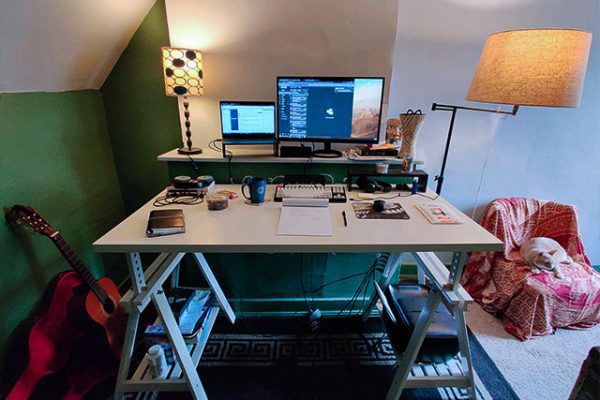As the weeks of COVID-19 virtual everything wear into months, and the months wear into half a year, it’s obvious (perhaps painfully so) that what started as a temporary measure has become the new norm. It’s increasingly likely that we will close out 2020 working 100% from home, yet most of us are not set up with anything remotely resembling a working desk, much less a home office. How many of us find ourselves nomadic throughout the day, carrying our laptop to the quietest part of the house? Working at the dining room table, on the couch, at the kitchen counter? Taking Zoom calls outside, in the attic, in a closet, or–even worse–in the bathroom? Stiff necks, sore backs, and headaches at the end of the day? If any of this sounds familiar, you may need to invest some time into rethinking your home workspace.
So, how can we do this when most of us are limited by space and/or money? Below are some tips for identifying the optimal learning and/or workspace considering your home environment. First and foremost, it is important to be realistic about your options. While we’d all love a corner office complete with floor-to-ceiling windows, an ergonomic chair, and the newest office equipment, that’s probably not in the cards for most of us. So it’s important to take honest stock of your options at home, then work with what you have. All is not lost – with a little creativity and resourcefulness, we can all create a comfortable space that enables us to be productive (and pain-free).
What to avoid:
- Beds and couches. Absolutely never, no way. This is a recipe for disaster. Working in bed will have naptime creeping up on your to-do list, and working anywhere that is soft and cushiony will seriously compromise your posture. As well as potentially causing chronic back and neck pain.
- Kitchen and dining room tables. These are not 100% no’s, but try to avoid working where your family gathers for meals. Unless you are someone who works entirely paperless, having to move your stuff every day gets old very quickly.
- The kitchen in general. We all love the proximity to the coffee machine and snacks, but having the fridge literally within arms reach can be very distracting.
- Anywhere the kids are. Not literally, because those of us with kids at home have to accept that it’s impossible, given current conditions, to completely separate the parental duties with work. But don’t set your office space up in the kids’ playroom, or bedroom, or where they watch television while you work.
- The floor. No and no.
What to do:
- Identify a space that can be completely yours. Even if you have to share a desk with a partner/spouse/roommate, carve out a corner of the desk that is only your stuff – your calendar, your pens, etc. It’s not the same as commuting to an office every day, but that sense of having a designated workspace can help create a line between your personal and professional lives.
- Invest in a decent chair (or find a desk that allows you to stand). It doesn’t have to be top-of-the-line, but if you are constantly readjusting your posture while working, you’re in the wrong chair. Hint: it’s like mattresses – chairs shouldn’t be either too soft or too hard.
- Find your preferred lighting. A desk lamp can go a long way toward creating the right atmosphere. Overhead lights can be artificially bright, so if possible, find a space with some decent natural light.
- Recreate your office space (as much as possible). Hang a whiteboard, bulletin board, or calendar if that’s what helps you get organized at the office. If you are reasonably able to replicate your desk at work, give it a try at home.
- Use calendars. We are all juggling schedules like never before, so keep yourself on track by posting your daily schedule in bold.
- Use this opportunity to avoid any mistakes you make at the office. Cluttered desk at work? Consciously minimize the clutter on your desk at home. Most of us don’t have a constantly-replenished supplies closet at home, so it should be easier to keep the office supplies to the necessary minimum.
- Try to feel like you’re in the office. If you have a picture of your kids, your dog, or your favorite vacation photo on your desk at work, go ahead and do so at home, too.
In conclusion…
If it’s still not feasible for you to have your own separate desk, don’t despair. If your only option is the dining room table, then go with it. Just try to claim one section of the table and create an imaginary (or real) boundary around your workspace. If you truly have no options for anything resembling a desk, then think about investing just a bit of money into a lap desk – you will need to elevate your laptop to avoid serious neck pain.
Finally, it’s important to remember that, while this may feel like a permanent change, we will eventually go back to “normal”. What that new normal will look like is anyone’s guess. It is quite likely that employees around the world will continue – post-pandemic – to work from home more often, so maximizing your home office space now will only benefit you in the future. Who knows, once we all start going back to the office, we may change our desks there to better reflect our workspaces at home!
For more DLS, check out other blogs and visit us on Facebook, LinkedIn, Instagram, or Twitter!
By Kate Marden




